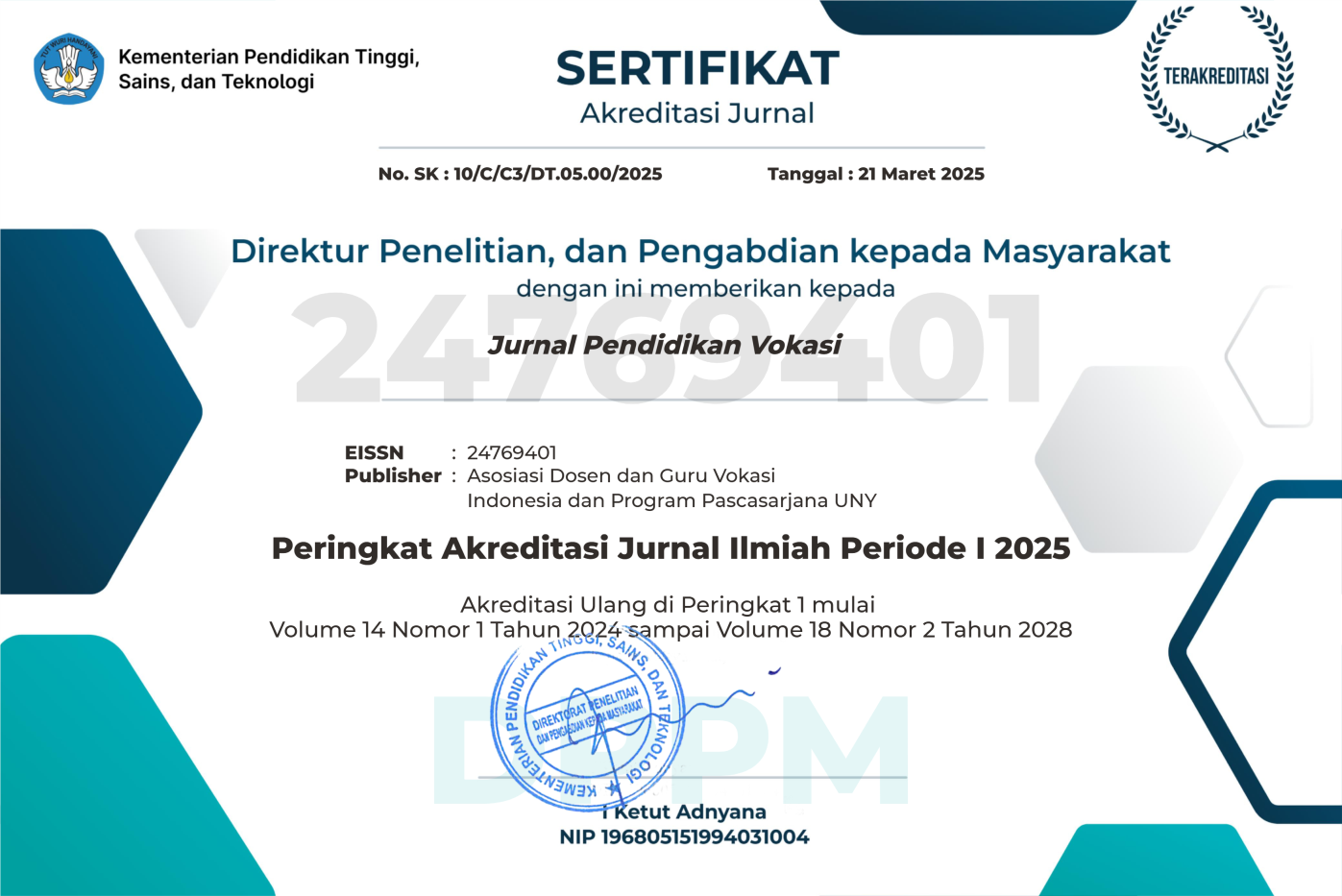Implementation of flipped learning to increase student learning activeness in the combustion engine lecture
DOI:
https://doi.org/10.21831/jpv.v14i2.66010Keywords:
Flipped learning, learning activeness, combustion engineAbstract
References
Agyeman, N. Y. B., & Aphane, V. (2024). Implementing flipped classroom to enhance student engagement: An action research. E-Journal of Humanities, Arts and Social Sciences, 1860–1878. https://doi.org/10.38159/ehass.202451119
Arlinah, D., Nasokha, N., & Firdaus, F. (2020). Penggunaan strategi pembelajaran flipped classroom pada pembelajaran daring untuk meningkatkan keaktifan siswa mata pelajaran IPA. JURNAL AL-QALAM: JURNAL KEPENDIDIKAN, 21(2), 15–24. https://ojs.unsiq.ac.id/index.php/al-qalam/article/view/2455
Bahadur, G., & Akhtar, Z. (2021). Effect of teaching with flipped class-room model: A meta analysis. FWU Journal of Social Sciences, 15(3), 96–112. https://doi.org/10.51709/19951272/Fall-2021/6
Bali, M. M. E. I. (2020). Penerapan model pembelajaran two stay two stray dalam meningkatkan keaktifan belajar pebelajar. Muróbbí®: Jurnal Ilmu Pendidikan, 4(1), 29–42. https://doi.org/10.52431/murobbi.v4i1.225
Bishop, J., & Verleger, M. (2013). The flipped classroom: A survey of the research. 2013 ASEE Annual Conference & Exposition Proceedings, 23.1200.1-23.1200.18. https://doi.org/10.18260/1-2--22585
Brookhart, S. M. (2013). How to create and use rubrics for formative assessment and grading. In SAGE Handbook of Research on Classroom Assessment (pp. 256–271). SAGE Publications, Inc. https://doi.org/10.4135/9781452218649.n15
Cheng, L., Ritzhaupt, A. D., & Antonenko, P. (2018). Effects of the flipped classroom instructional strategy on students' learning outcomes: A meta-analysis. Educational Technology Research and Development, 67, 793–824. https://link.springer.com/article/10.1007/s11423-018-9633-7
Collins, H. (2025). Creative research: Research theory and practice for the creative industries. Bloomsbury Publishing.
Dewi, L. Y. (2022). Penerapan model pembelajaran flipped leaning untuk meningkatkan aktivitas dan keterampilan menulis puisi siswa kelas X SMA Negeri 5 Surakarta [Universitas Sebelas Maret]. https://digilib.uns.ac.id/dokumen/detail/90595/Penerapan-Model-Pembelajaran-Flipped-Leaning-untuk-Meningkatkan-Aktivitas-dan-Keterampilan-Menulis-Puisi-Siswa-Kelas-X-SMA-Negeri-5-Surakarta
Effendi, M. (2013). Integrasi pembelajaran active learning dan internet-based learning dalam meningkatkan keaktifan dan kreativitas belajar. Nadwa: Jurnal Pendidikan Islam, 7(2), 283–309. https://journal.walisongo.ac.id/index.php/Nadwa/article/view/563
Fahmy, A. F. R., Sari, N. H. M., Yuniati, M., & Ramanda, E. (2022). Implementasi pembelajaran flipped classroom berbantuan geogebra pada mata kuliah analisis vektor ditinjau dari locus of control mahasiswa. Integral : Pendidikan Matematika, 12(2), 42–51. https://doi.org/10.32534/jnr.v12i2.2539
Farida, R., Alba, A., Kurniawan, R., & Zainuddin, Z. (2019). Pengembangan model pembelajaran flipped classroom dengan taksonomi bloom pada mata kuliah sistem politik Indonesia. Kwangsan: Jurnal Teknologi Pendidikan, 7(2), 104–122. https://doi.org/10.31800/jtp.kw.v7n2.p104--122
Fleagle, T. R., Borcherding, N. C., Harris, J., & Hoffmann, D. S. (2018). Application of flipped classroom pedagogy to the human gross anatomy laboratory: Student preferences and learning outcomes. Anatomical Sciences Education, 11(4), 385–396. https://doi.org/10.1002/ase.1755
Freeman, S., Eddy, S. L., McDonough, M., Smith, M. K., Okoroafor, N., Jordt, H., & Wenderoth, M. P. (2014). Active learning increases student performance in science, engineering, and mathematics. Proceedings of the National Academy of Sciences, 111(23), 8410–8415. https://doi.org/10.1073/pnas.1319030111
Hew, K. F., & Lo, C. K. (2018). Flipped classroom improves student learning in health professions education: A meta-analysis. BMC Medical Education, 18(1), 38. https://doi.org/10.1186/s12909-018-1144-z
Kemmis, S., McTaggart, R., & Nixon, R. (2014). The action research planner: Doing critical participatory action research. Springer. https://eprints.ukh.ac.id/id/eprint/269/1/2014_Book_TheActionResearchPlanner.pdf
Lí¥g, T., & Sí¦le, R. G. (2019). Does the flipped classroom improve student learning and satisfaction? A systematic review and meta-analysis. AERA Open, 5(3). https://doi.org/10.1177/2332858419870489
Luo, H., Yang, T., Xue, J., & Zuo, M. (2019). Impact of student agency on learning performance and learning experience in a flipped classroom. British Journal of Educational Technology, 50(2), 819–831. https://doi.org/10.1111/bjet.12604
Magdalena, I., Sulaiman, A. M. S., & Sukma, F. R. (2023). Analisis implementasi desain pembelajaran pada proses pembelajaran di SDN Cikokol 1 Kota Tangerang. MASALIQ, 3(3), 384–389. https://doi.org/10.58578/masaliq.v3i3.984
Mardian, W., & Sylvia, I. (2020). Upaya meningkatkan keaktifan belajar melalui penerapan model students divisions achievement divisions di XI IPS 1 SMANegeri 1 Bukittinggi. Jurnal Sikola: Jurnal Kajian Pendidikan Dan Pembelajaran, 1(3), 207–214. https://doi.org/10.24036/sikola.v1i3.31
Masyhud, M. S., & Tasnim, Z. (2012). Metode penelitian pendidikan, penuntun teori dan praktik penelitian bagi calon guru, guru dan praktisi pendidikan. Lembaga Pengembangan Manajemen dan Profesi Kependidikan (LPMPK).
Nizhomi, B., Nisa, A. F., & Pusporini, W. (2022). Implementasi model pembelajaran flipped classroom guna meningkatkan interaksi belajar mahasiswa pada mata kuliah pembelajaran tematik SD. Caruban: Jurnal Ilmiah Ilmu Pendidikan Dasar, 5(2), 140. https://doi.org/10.33603/caruban.v5i2.7015
Prince, M. (2004). Does active learning work? a review of the research. Journal of Engineering Education, 93(3), 223–231. https://doi.org/10.1002/j.2168-9830.2004.tb00809.x
Respati, Y. A. (2019). Collaborative learning dalam upaya peningkatan keaktifan mahasiswa pada proses pembelajaran. EFISIENSI - KAJIAN ILMU ADMINISTRASI, 15(2), 15–23. https://doi.org/10.21831/efisiensi.v15i2.24490
Rizki, I., Marzuki, M., & Sadrina, S. (2019). Penerapan model pembelajaran problem based learning untuk meningkatkan keaktifan siswa kelas XI pada mata pelajaran perekayasaan sistem radio dan televisi di SMK Muhammadiyah 1 Banda Aceh. CIRCUIT: Jurnal Ilmiah Pendidikan Teknik Elektro, 3(1), 19. https://doi.org/10.22373/crc.v3i1.4241
Serin, H. (2018). A Comparison of Teacher-Centered and Student-Centered Approaches in Educational Settings. International Journal of Social Sciences & Educational Studies, 5(1), 164–167. https://doi.org/10.23918/ijsses.v5i1p164
Downloads
Published
How to Cite
Issue
Section
Citation Check
License
The authors submitting a manuscript to this journal agree that, if accepted for publication, copyright publishing of the submission shall be assigned to Jurnal Pendidikan Vokasi. However, even though the journal asks for a copyright transfer, the authors retain (or are granted back) significant scholarly rights.
The copyright transfer agreement form can be downloaded here: [JPV Copyright Transfer Agreement Form]
The copyright form should be signed originally and sent to the Editorial Office through email to jpvokasi@uny.ac.id
Jurnal Pendidikan Vokasi by http://journal.uny.ac.id/index.php/jpv is licensed under a Creative Commons Attribution-ShareAlike 4.0 International License.













